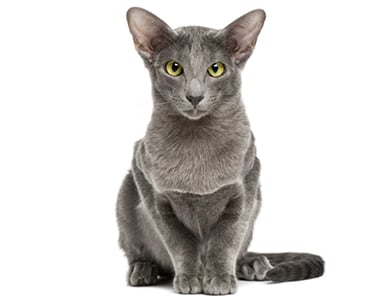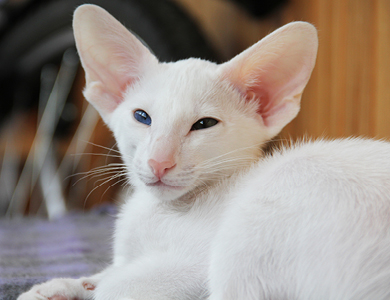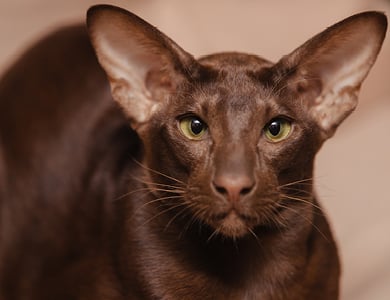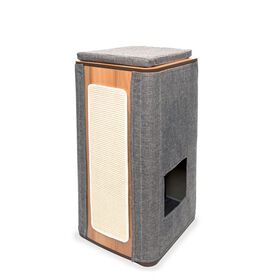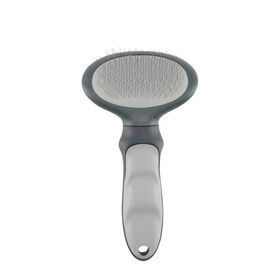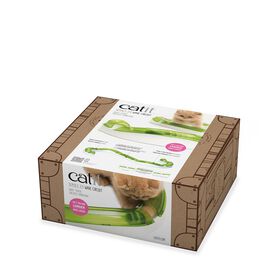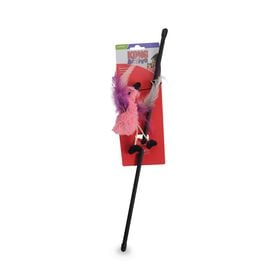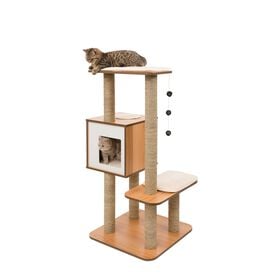This Siamese cousin is distinguished from other so-called "oriental" cats by the almost endless possibilities of colors, patterns and effects of its coat. In fact, only the "colourpoint" type pattern is not found on the Oriental shorthair since it is reserved for its cousin the Siamese! Here is a little more about this colorful cat.
Morphology and appearance
The Oriental Shorthair lives up to its name as it respects the extreme look of oriental-type cat breeds in every way: long, from the tip of the nose to the tip of the tail. This feline has fine bones, a tubular body and long legs all the way down to their fingertips, which gives it the slender and graceful appearance of a dancer while remaining athletic like a sprinter. Even its tail is long and slender. Its head is no exception to the rest of the body and forms a long, angular triangle that ends in a thin elongated muzzle. The ears, broad at their base and fabulously large, accentuate the triangle effect of the head. The eyes, preferably green, are almond shaped and slightly angular to follow the triangular shape of the head.
The Oriental shorthair's coat is short and very close to the body, contributing to its slim appearance. Glossy, it comes in all possible colors, and these colors can be solid, torties, tabby, two-tone, tricolor and even silvers or smokes. There are nearly 300 possible coats for this cat.
Level of maintenance (grooming)
Easy to groom, the Oriental shorthair will only require occasional brushing and regular checking of the ears and eyes to make sure they stay clean.
Behaviour
An Oriental's shorthair personality is generally as colorful and diverse as his coat can be. He is often described as a very sociable, vocal cat who seeks attention and is eager to participate in the activities of his humans. He may need a feline companion to avoid getting bored (provided that this companion is also the very social type with his peers). His athletic physique promotes a high level of activity and an excellent ability to jump, sometimes very high. This is the type of cat who loves to play, climb, learn tricks and even practice agility. He greatly appreciates the cat trees, heights, playing fetch or more simply, playing with an empty box. Of course, this description may not represent your oriental shorthair. After all, they all have their own unique personality!
Origins
The oldest traces of the Oriental shorthair are found in Thailand. Indeed, the Oriental being essentially a Siamese in a non-pointed dress, he rubbed shoulders with his "colourpoint" counterpart in the streets of Siam (the old name of Thailand). It was imported to England in the mid-1800s, around the same time as the Siamese, but the latter's blue eyes and distinctive dress were preferred. It was not until after World War II that the Oriental shorthair resurfaced in England. But this time around, it is the result of voluntary crossbreeding by Siamese breeders with cats of other breeds. Since there were very few purebred cats left at this time, it sometimes took the imagination to reconstruct the genetic pools. At the same time, the chocolate color was introduced to the Siamese. The first crossings resulted in the reappearance of plain dresses, the “colourpoint” pattern being recessive. These cats were again mated to Siamese and their offspring with pointed coats could swell and improve the genetic pool of the Siamese. However and at the same time, kittens identical to Siamese in all respects but with a colorful coat appeared in the litters. They are the basis of modern Oriental shorthair.
If at first an attempt was made to develop and name each color as a separate breed, it soon became apparent that there were far too many possibilities. We therefore grouped all the "non-pointed Siamese" into a single breed: the Oriental Shorthair. It then conquered America, but only in the 1970s.
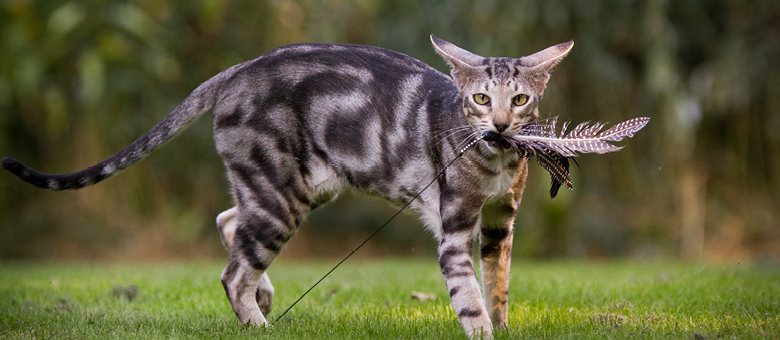
Unusual facts
The Havana is one of the united colorful breeds created at the very beginning of the craze for what would become the modern Eastern Shorthair. However, it evolved into a breed completely distinct from the Oriental, after its importation to the United States, by the second half of the 1950s.
In different feline associations around the world, there are a few variations in the colors and coat patterns that may or may not be accepted in Oriental shorthairs. Also, from one association to another, the categories in which the Oriental can compete may vary depending on the color or pattern of his dress.


